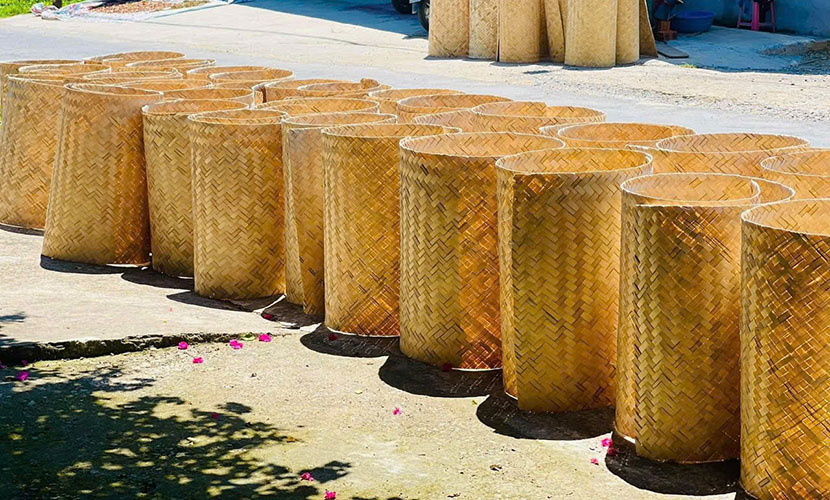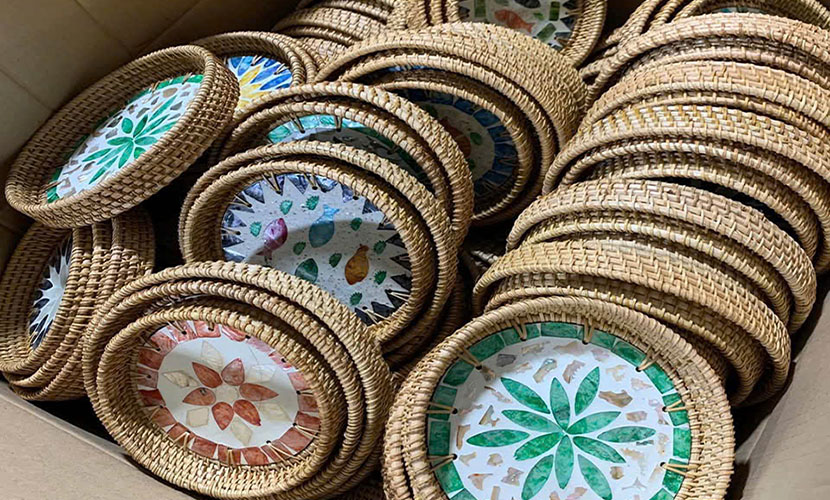
Vietnam’s bamboo and rattan products are facing a breakthrough opportunity as exports grow strongly. They aim to capture 10–15% of the global market and generate billions of USD by 2028.
As of the end of August 2025, export turnover for bamboo, rattan, seagrass products, and carpets reached $574 million. This figure showed an increase of 5.4% compared to the same period last year.
The United States remains the largest export market of Vietnam’s bamboo and rattan products. This market generated a turnover of $266 million, accounting for 46.3% of the total value. Next markets are Japan ($37.7 million), the UK ($28.5 million), Spain ($27.6 million), and India ($21.57 million).

Vietnamese bamboo and rattan products
In 2024, the total export value of Vietnamese handicraft products reached $804 million. It showed that there is still significant growth potential for Vietnam’s bamboo and rattan products.
Bamboo and rattan products currently represent the highest export value group among non-timber forest products. Vietnam, along with China, ranks among the top five largest exporters of bamboo and rattan products globally. These handmade products are increasingly popular in international markets, especially in interior design and home decor.
In recent years, more and more buyers from developed countries have visited production workshops in Vietnam. Orders have continuously increased due to the advantages of high aesthetics, stable quality, and competitive prices. In Europe, consumers particularly favor unique, eco-friendly products that reflect cultural identity.

Vietnamese rattan boxes
The Vietnam Handicraft Exporters Association believes the bamboo and rattan products have the potential to capture 10–15% of the global market within the next few years. If the current growth momentum continues, Vietnam’s bamboo and rattan exports could contribute billions of dollars to the national economy.
Currently, the global handicraft market continues to expand, creating more opportunities for Vietnamese handmade products. Furthermore, free trade agreements allows businesses easier access to technology, international experience, and deeper integration into global supply chains. Especially in the digital era, the adoption of e-commerce and artificial intelligence will become a new catalyst for the industry’s growth.
However, alongside these opportunities, the bamboo and rattan industry still faces many challenges. They are fierce competition in design and standards, high production costs, limited marketing, and a shortage of skilled labor. Many production villages are small-scale, fragmented, and lack the connections needed to form a global supply chain. Additionally, global economic fluctuations, inflation, and rising logistics costs directly impact market expansion.

Vietnamese bamboo straws
According to Mr. Dat, Chairman of the Vietnam Craft Villages Association, to help the handicraft industry reach global markets and achieve its billion-dollar goals, six strategic solutions must be prioritized:
Sustainable raw material planning
Establish well-managed resource areas to ensure the legal and traceable sourcing of materials. In addition, strengthen links between enterprises and local raw material suppliers.
Human resource development
Combine traditional craft training with advanced design and technical skills. Also, encourage younger generations to take up the craft and attract professional designers to participate in product development.
Technology innovation and digital transformation
Introduce environmentally friendly machinery to improve product quality and reduce costs. At the same time, digitize products, artisans, and village heritage while leveraging e-commerce.
Market expansion at home and abroad
Conduct market research to understand customer preferences, design suitable products, and boost trade promotion. In addition, participate in international fairs, and develop craft village tourism that combines hands-on experience with direct purchasing.
Environmental protection and green development
Use eco-friendly materials and treat waste according to standards. Moreover, mobilize the coordinated participation of the government, citizens, and society.
Government support policies
These include financial incentives, credit support, infrastructure investment, intellectual property protection. The aim is to helping enhance the value and competitiveness of Vietnamese handicrafts.
With the right orientation and coordinated strategies, Vietnam’s bamboo and rattan industry can fully capitalize on green consumption trends to make a breakthrough. In addition, it asserts its brand in the global market, and contribute to preserving and promoting traditional cultural values.
Vietnamese source: https://thuehaiquan.tapchikinhtetaichinh.vn/co-hoi-but-pha-cho-nganh-may-tre-dan-viet-nam-199477.html&link=autochanger
